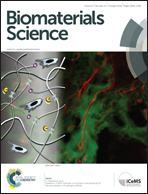Graphene oxide modified with aptamer-conjugated gold nanoparticles and heparin: a potent targeted anticoagulant†
Abstract
Graphene oxide (GO) modified with 29-mer thrombin-binding-aptamer-conjugated gold nanoparticles (TBA29–Au NPs/GO) can synergistically inhibit the thrombin-mediated cleavage of fibrinogen to fibrin. To further improve anticoagulation efficiency in human plasma, TBA29–Au NPs/heparin/GO has been prepared from TBA29–Au NPs/GO and heparin that can also bind thrombin. The dose-dependence of thrombin clotting time (TCT) delay caused by TBA29–Au NPs/heparin/GO is 21.4, 17.0 and >100 times higher than that caused by the TBA29–Au NPs, TBA29–Au NPs/GO and commercially available drugs (heparin, argatroban, hirudin or warfarin), respectively.


 Please wait while we load your content...
Please wait while we load your content...